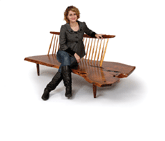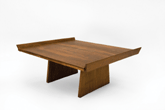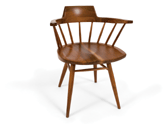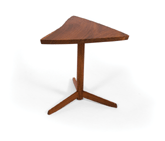ChairMan

Standing in the center of a large, open space, Rachel Stadelmeier chats with a small crowd gathered around her. She wears a black dress, the gallery’s stark white walls in the distant background. It’s not the only paradox on display. Just outside the campus’s Regina Miller Gallery, students play ultimate Frisbee in T-shirts; inside, the patrons are dressed as one would expect for an art opening—evening dresses, business suits. Not insignificantly, within the gallery there’s no place to sit, which is especially striking in a room full of furniture.
As Stadelmeier describes it, the artist whose work is on display, George Nakashima, might have appreciated the irony. He crafted his pieces as a true artisan, but intended them always to be used as everyday furniture. When Warner Hall was built in 1966, Nakashima was commissioned to furnish it—pieces intended for offices rather than galleries. Forty-one years later, going inside that severe, metallic, modernist building, it’s easy to be struck by the warm and exotic wooden desks, tables, and chairs that are still very much in use.

“I think the first time I saw a Nakashima piece was probably the bench in the Admissions Office,” says Stadelmeier (A’07). “You know, covered in magazines, people sprawled on it, this beautiful thing nonetheless.” Since then, she’s gotten to know Carnegie Mellon’s collection—the bench and 60 other pieces—intimately. She and a small cadre of classmates, as part of their Senior Studio project, spent a semester planning, designing, and executing the fall exhibition.
Watching the crowd filter through the exhibit, she looks equal parts relieved and overjoyed. “Every little thing had to be managed” to bring it to life, she confesses. She remembers when the exhibit was a breadbox-sized model in a classroom, with Stadelmeier and other students fretting over it, rearranging, offering suggestions and criticisms.

Now, for the opening, she can finally relax. It turns out to be the largest in the gallery’s history. “I’m really proud,” she offers, and as she scans the crowd her expression would indicate that she means it. “These are such beautiful pieces, so much amazing, one-of-a-kind furniture, and we should keep using it. But maybe,” she adds, “people will start using coasters.”

She seems like she wants to add to that thought, but another patron taps her on the shoulder, wanting to congratulate her. Her smile widens, and she tucks some of her blonde curls behind her ear as the man talks about being inspired by a beautiful coffee table nearby.
— Bradley A. Porter (HS’08)



